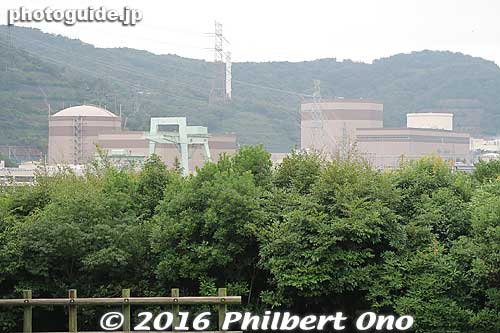
Fukushima’s nuclear power plant crisis has rattled the nerves of Shiga’s residents and local governments. We are beginning to realize how vulnerable Japan’s nuclear power plants are, how vulnerable nearby residents are, how power companies have deceived the public about nuclear plant safety, how inept they are in emergencies, and how the government nuclear watchdog and power companies have ignored safety warnings and advice from nuclear and earthquake experts for years. Sadly, the Fukushima accident could have been largely or completely prevented.
Shiga Prefecture is next to Fukui Prefecture in the north, where a string of eleven nuclear power plants dot the coast of Wakasa Bay in three locations. This is Japan’s highest concentrations of nuclear power plants. The closest nuclear reactor is only 13 km (8 mi.) from Shiga Prefecture’s border in Yogo (northern Nagahama).
The nuclear plants in Fukui are operated by Kansai Electric Power Co. (KEPCO) which supplies electricity to most of the Kansai and Kinki regions, including Shiga, Kyoto, Osaka, Hyogo, Nara, and parts of Mie, Gifu, and Fukui Prefectures. About 48% of KEPCO’s power is generated by nuclear plants, all in Fukui. This is the highest percentage of any region of Japan. Compare this with the Tokyo region’s 23% dependence on nuclear power before the Fukushima accident. Overall, Japan relied on nuclear power for about 23% of the power generated before the Fukushima accident. In its advertising, KEPCO has actually been boasting that half of its power is nuclear-generated. Say that now, and many of us in Kinki/Kansai will only shudder.
When the evacuation zone around the Fukushima nuclear plants was expanded from 10 km to 20 km (12 mi.), alarm bells went off in the governor’s office in Shiga. According to the safety manual, the standard evacuation zone around a troubled nuclear plant in Japan was to be only 10 km (6 mi.). If this overly optimistic scenario were to be trusted, Shiga would be in the clear. But 20 km meant that residents in northern Shiga would fall in the evacuation zone if a nuclear accident occurred in Fukui. This has prompted Shiga Governor Kada Yukiko to order a revamp of Shiga’s countermeasures against nuclear plant emergencies. The existing plan assumes that the evacuation zone will be 10 km. Thus, it does not include any evacuation plans for Shiga residents since we are farther than 10 km away. But Shiga must now incorporate evacuation plans in its countermeasures as soon as they figure out how far the evacuation zone should be. They must also take wind conditions into account.
I wonder though, if 20 km is a realistic distance when you think about the US government’s recommended 80 km (50 mi.) which would reach deep into Shiga territory from Wakasa Bay. However, evacuating Shiga residents within 80 km would be extremely disruptive and very difficult as it would include heavily populated areas. It is understandable for authorities to keep the evacuation zone as small as possible. Also, any major radiation leaks from Fukui would inevitably contaminate Lake Biwa which supplies water to the Kansai region. The stakes are very, very high when it comes to nuclear power safety.
Meanwhile, to ease our fears, KEPCO has announced major reinforcements and additional backup power supply and pumping systems to be installed or built. They also plan to build an anti-tsunami wall and also thoroughly train workers for emergencies. They will spend 5 to 10 trillion yen (about $595 million to $1.19 billion) on these countermeasures.
Well, that’s nice to hear. But it also implies that their nuclear reactors’ safety measures have been pretty inadequate during all these decades since the 1970s when most of them were built. Like right now, they are geared for only a 2-meter-high tsunami. Fukushima’s tsunami was well over 10 meters. These nuclear power plants have not been accident-free either. For example, in 2004, the Mihama nuclear plant had hot steam scalding five workers to death.
Let’s hope and pray that Japan, the power companies, and the entire world will learn from Fukushima and we will never see something like this ever again.





